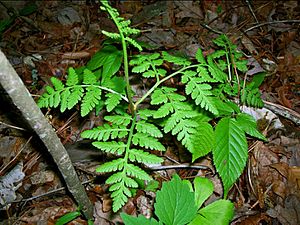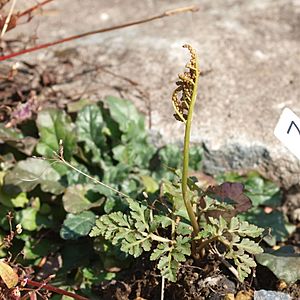Moonwort facts for kids
Quick facts for kids Moonwort |
|
|---|---|
 |
|
| Botrychium lunaria | |
| Scientific classification |
|
| Kingdom: | Plantae |
| Clade: | Tracheophytes |
| Class: | Polypodiopsida |
| Order: | Ophioglossales |
| Family: | Ophioglossaceae |
| Subfamily: | Botrychioideae |
| Genus: | Botrychium Sw. |
| Species | |
|
Several, see text |
|
Botrychium is a group of small ferns, often called moonworts. These plants are special because they don't grow from seeds. Instead, they reproduce using tiny spores that float in the air. Moonworts have thick, fleshy roots.
A moonwort leaf has two main parts. One part, called the trophophore, looks like a regular fern leaf and helps the plant make food. The other part, called the sporophore, is where the spores are made. It holds small cases filled with spores. Some moonworts spend most of their lives hidden underground. They get their food from a special partnership with tiny fungi in the soil.
Scientists sometimes disagree on how to group moonworts. Some think certain types, like Botrypus and Sceptridium, should be part of Botrychium. Others believe they are separate groups. In this article, we will treat them as distinct groups for now.
Contents
Different Kinds of Moonworts
There are many different kinds of moonworts, and they can look quite different from each other. Scientists give each type a unique name. Here are a few examples of the main moonworts:
- 'Botrychium acuminatum W.H.Wagner 1990 – known as the pointed moonwort.
- 'Botrychium ascendens W.H.Wagner 1986 – called the upswept moonwort.
- Botrychium lunaria (L.) Sw. 1801 – this is the common moonwort.
- Botrychium simplex E.Hitchc. 1823 – known as the least moonwort, because it is very small.
Rattlesnake Fern: A Close Relative
The rattlesnake fern is a type of plant that looks a bit like a moonwort. It was once thought to be a part of the Botrychium group. However, many scientists now place it in its own group called Botrypus. It is sometimes called the common grapefern.
- Botrychium virginianum (L.) Sw. 1801 – This is the rattlesnake fern.
- It is also known as Botrypus virginianus (L.) Michx. 1803.
Evergreen Grapeferns: Another Group
There are also plants called evergreen grapeferns. These plants were also once considered part of the Botrychium family. They are now often placed in their own group called Sceptridium. These ferns are called "evergreen" because their leaves stay green all year.
- Botrychium dissectum Sprengel 1804 – This is the dissected grapefern.
- Botrychium multifidum (S.G. Gmel.) Rupr. 1859 – Known as the leather grapefern.
- Botrychium rugulosum W.H.Wagner 1982 – This is the St. Lawrence grape fern.
Protecting Moonworts: Conservation Efforts
Moonworts can grow in many different places. You might find them in prairies, forests, or even mountains. Some types of moonworts are very rare. Trying to protect them can be tricky.
It's hard to count how many moonworts there are. Their leaves are very small, usually only 2 to 10 centimeters tall. This makes them hard to spot. Even more challenging is that most of a moonwort's life happens underground.
The Hidden Life Cycle of Moonworts
Moonworts have a fascinating life cycle. They can stay hidden in the soil for a long time.
- Spores: Moonworts release tiny spores. These spores need to go deep into the soil, away from light, to start growing. This helps them find special fungi they need to survive.
- Underground Growth: Once a spore sprouts, it forms a tiny, heart-shaped plant part called a gametophyte. This part also lives completely underground.
- Asexual Reproduction: Some moonworts can also make new plants from their roots. This is a type of asexual reproduction, meaning they don't need spores to make new plants.
Even mature moonworts don't always grow a leaf above ground every year. They can stay alive underground for up to 10 years without showing any green parts. This is possible because they rely on a partnership with certain fungi. These fungi provide the moonworts with most of the food they need to grow and reproduce.
Because of this special partnership with fungi, it's very hard to grow moonworts in a lab. Scientists have only been able to get the underground gametophyte part to sprout so far.
See also
 In Spanish: Botrychium para niños
In Spanish: Botrychium para niños



